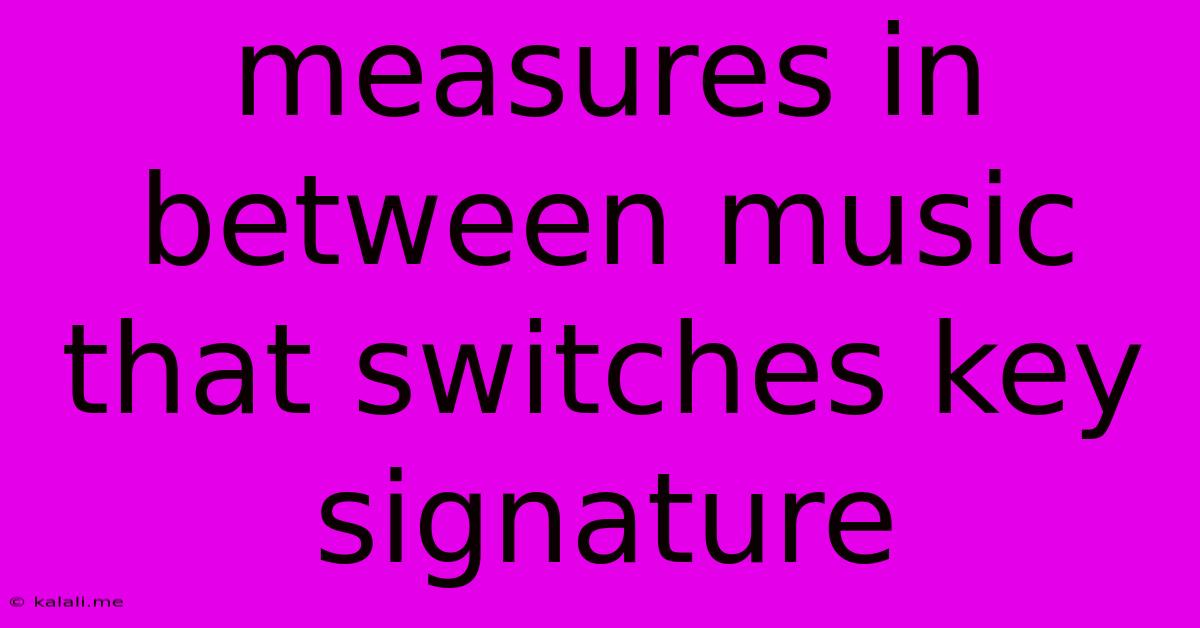Measures In Between Music That Switches Key Signature
Kalali
Jun 03, 2025 · 3 min read

Table of Contents
Navigating the Transitions: Measures Between Key Signature Changes
Changing key signatures mid-song adds color, drama, and emotional depth. But how do you effectively navigate the measures between those key changes? This article explores the techniques composers use to smoothly transition between different key signatures, ensuring a seamless and musically satisfying experience for the listener. Understanding these techniques is vital for both composers and arrangers aiming to create sophisticated and engaging musical pieces.
Understanding Key Signature Changes
Before delving into transitional measures, let's briefly review why and how composers change key signatures. A key signature, indicated by sharps or flats at the beginning of a staff, establishes the tonal center and the notes that are considered "home." Changing key signatures often signifies a shift in mood, emotion, or thematic development. Common transitions involve moving to closely related keys – for example, from C major to G major (a dominant key relationship) or from C major to F major (a subdominant key relationship). These related keys share many notes, making transitions smoother.
Techniques for Smooth Transitions
The measures between key signature changes are crucial for bridging the gap between tonal centers. Here are some effective techniques:
1. Modulation through intermediary chords: Instead of abruptly shifting, composers often use intermediary chords to gradually modulate to the new key. This might involve using a pivot chord – a chord containing notes common to both the old and new key signatures. The pivot chord acts as a bridge, allowing the ear to smoothly adapt to the new tonal center. For example, transitioning from C major to G major might involve using a D7 chord (dominant in C, secondary dominant in G).
2. Chromatic approaches: Chromaticism – the use of notes outside the current key – can subtly prepare the listener for the upcoming key change. Introducing chromatic passing tones or neighboring tones in the measures leading up to the key change can create a sense of anticipation and smooth the transition.
3. Sequential progressions: Repeating a chord progression, slightly altering it each time, can effectively lead the listener to the new key. This technique builds anticipation and allows the ear to acclimate to the new tonal context before the key signature change officially occurs.
4. Cadences: Using a half cadence or imperfect authentic cadence in the old key, followed by a phrase beginning in the new key, provides a natural pause and a clear point of departure. This allows the listener to appreciate the shift and follow the new progression.
5. Emphasis on melodic lines: A strong melodic line that spans the key change can cleverly mask the transition. The listener's focus remains on the melody, making the key change less jarring. The melody itself can provide a path guiding the listener to the new tonality.
6. Careful use of harmony: Employing appropriate harmonies that foreshadow the new key is crucial. Dominant chords resolving to the tonic of the new key are often used effectively to achieve this. Using secondary dominants or borrowed chords adds complexity and assists in smoothing the shift.
Analyzing Examples
Analyzing works by masters like Bach, Beethoven, or Mozart offers invaluable insight into how these techniques are applied in practice. Observe how they use chord progressions, melodic lines, and harmonic vocabulary to create seamless key changes within their compositions.
Conclusion
Mastering the art of transitioning between key signatures involves more than just changing the sharps or flats. It demands careful consideration of harmony, melody, rhythm, and the overall musical context. By understanding and employing these techniques, composers and arrangers can elevate their work, creating pieces that are not only technically proficient but also emotionally resonant and aesthetically pleasing. Remember to listen to a wide variety of music, paying close attention to how composers handle these crucial transition moments, to further refine your understanding and skill.
Latest Posts
Latest Posts
-
If Function In Google Sheet Data Validation
Jun 04, 2025
-
How To Know When Noodles Are Done
Jun 04, 2025
-
Select From Another Select With More Than 1 Return
Jun 04, 2025
-
How To Paint A Painted Deck
Jun 04, 2025
-
How To Stop Pasta From Boiling Over
Jun 04, 2025
Related Post
Thank you for visiting our website which covers about Measures In Between Music That Switches Key Signature . We hope the information provided has been useful to you. Feel free to contact us if you have any questions or need further assistance. See you next time and don't miss to bookmark.